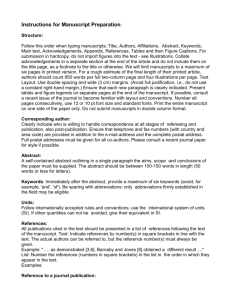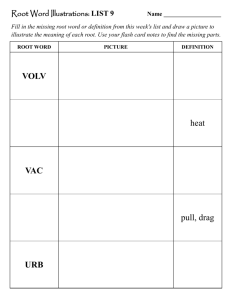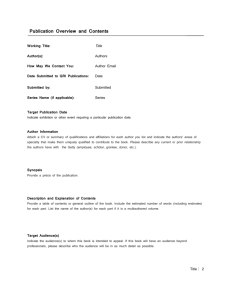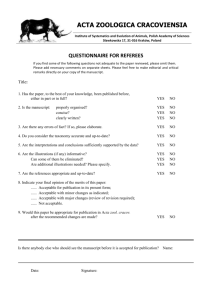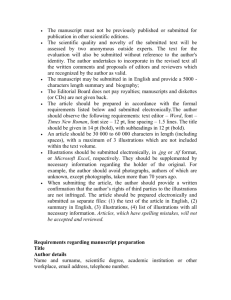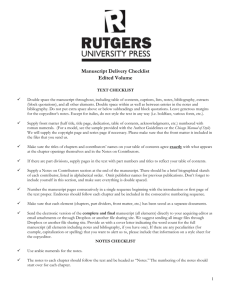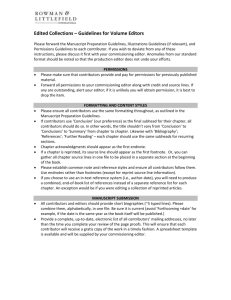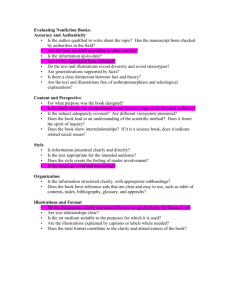Contributor Guidelines
advertisement
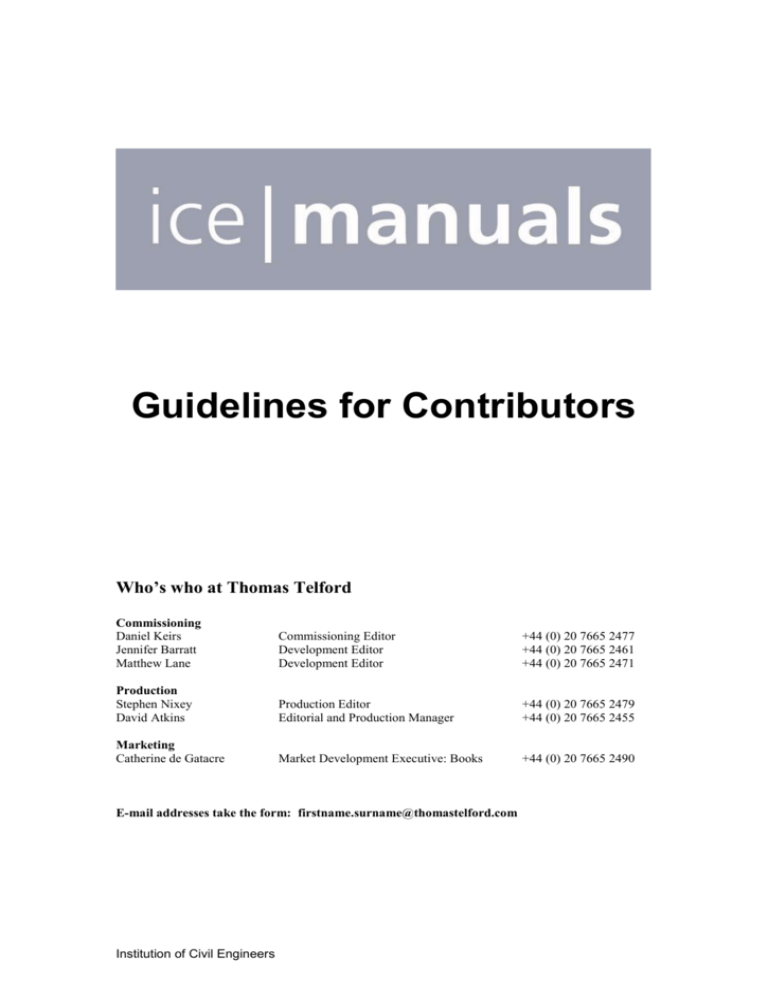
Guidelines for Contributors Who’s who at Thomas Telford Commissioning Daniel Keirs Jennifer Barratt Matthew Lane Commissioning Editor Development Editor Development Editor +44 (0) 20 7665 2477 +44 (0) 20 7665 2461 +44 (0) 20 7665 2471 Production Stephen Nixey David Atkins Production Editor Editorial and Production Manager +44 (0) 20 7665 2479 +44 (0) 20 7665 2455 Marketing Catherine de Gatacre Market Development Executive: Books +44 (0) 20 7665 2490 E-mail addresses take the form: firstname.surname@thomastelford.com Institution of Civil Engineers Guidelines for contributors Guidelines for contributors Before you start to prepare your manuscript, please take time to read these guidelines. They are intended to provide you with the practical guidance you will require in order to produce your manuscript. Please take time to review the requirements to ensure that you present the material in a way that not only conforms to your contractual agreement, but that will make production a straightforward process. If you have any queries please consult with the editorial or production teams. Contents Preparing your chapter Length of typescript Chapter structure Illustrations and tables - preparation Line illustrations Halftones Tables Captions and numbering Preparation of references General points of style Supplying your manuscript Copyright and permissions Checking proofs 2 2 2 3 3 4 4 4 5 6 6 7 9 Copyright permission request form Contributor guidelines: Apr 09 1 Guidelines for contributors Preparing your chapter Length of typescript It is important that the length of your typescript is in accordance with that agreed with your editor. You should plan your work carefully to ensure that the overall length of the final work (including illustrations, references, appendices and other items) conforms to that agreed. You are encouraged to use the “word count” facility of your word processor to keep track of progress. Chapter structure This section aims to provide guidance on how to put together your chapter. Your chapter should include the following elements in the order given below. Title The title and main sections will have been provided by your Section Editor, however, there is some flexibility in layout. A chapter title should definitively describe the material that follows, and be no more than 10 words in length. Abstract Abstracts should be a maximum of four sentences in length, roughly 200 words. Abstracts should be able to be read as standalone items and should avoid phrases such as “this chapter discusses…”. An abstract should not contain citations or references. It will often be used as a primary point of search, so the abstract should contain the key words relating to the chapter. Key words Up to five key words; these can be used for indexing and linking. Introduction Background information: so as to introduce the reader to the topic of the chapter. Main text (body text) The body text should incorporate main headings and sub-headings to a maximum of 3 levels (“a” heading – main heading, “b” and “c”). ICE manuals are designed to be highly referenced and illustrated. Line drawings, photographs, tables, case studies and key learning points should be used wherever possible. References All references must be cited in the text. Refer to source material in the text by citing author surname and year in parenthesis e.g. (Bloggs and Jones, 1999). For references with more than two authors please use et al., for example (Bloggs et al., 1999). A full reference list should be set at the end of your chapter using the Harvard conventions. (see Preparation of references) Further reading list These are titles not cited in the text but are provided for additional background and should be listed at the end of the chapter – they may be journal papers, reports, standards, book chapters or whole books. Please include a full reference. Web references Please include any website references which may offer up salient further information for the reader in relation to your chapter. Contributor guidelines: Apr 09 2 Guidelines for contributors Illustrations and tables – preparation Please do not embed illustrations within the text document but include a figure flag e.g. <fig 1.1 near here>. All electronic illustrations should be supplied separately; either as electronic files or as hardcopy. Each figure should be cited in the text. To ensure that illustrations are prepared in an appropriate format for reproduction, please refer to the guidance below. In production terms, illustrations are divided into two categories: Line illustrations Halftones (including photographs). Line illustrations Line illustrations are those that contain only lines and text, with some areas of solid colour or tint, e.g. graphs, pie charts, flow charts, plans, diagrams. Thomas Telford Publishing can accept figures as either hardcopy original or as electronic files (not less than 600 dpi). Sketches If authors do not have access to illustration facilities, or the illustrations are very simple in format, authors can supply a clearly drawn sketch of each figure on white paper, ensuring that any lettering is legible and that any important features are clearly identified. We will redraw these inline with our house style and suitable for publication. Line illustrations to be re-lettered Authors may wish to provide material that has been drawn to an appropriate standard, but which is either not annotated, or is annotated in an inconsistent style. We are able to scan artwork and electronically re-letter, incorporating any new lettering required. This option requires that the original artworks are in a format suitable for scanning, i.e.: Draw at actual (final) size of use in the printed book, or allow for reduction/enlargement if bigger/smaller than page size. Use line thicknesses no less that 0.25 mm/0.5 pt (after enlargement/reduction). Avoid using tints (these reproduce poorly from scanned material). Type size should be consistent, and allow for reduction/enlargement of the figure (type size after re-sizing should be 8pt). Spelling, punctuation etc must be accurate and consistent (with each other and with the text). Supply on white paper. Electronic artwork formats The preferred format for electronic line artwork is EPS (encapsulated postscript). This format allows for correction and alterations to artwork by typesetters and illustrators, and can be resized without loss of quality. PDF format is also recommended. TIFF format is suitable for figures that are to be re-lettered, though please ensure that the resolution is not less than 800dpi at final size. TIFF format files may lose quality when enlarged, so please aim to supply TIFF format figures at final size (or larger). The principal advantage of EPS over TIFF is that the annotation in EPS files can be edited, whereas in TIFF files the annotation is part of the graphic and can not be directly edited. Line figures prepared in Word or other word-processors can not be used as electronic artwork – such illustrations will be scanned and re-lettered or redrawn from print-outs. When preparing electronic line artwork, please note the following: Avoid supplying JPEG, GIF and AutoCAD files. Avoid supplying application files without prior consultation with your commissioning editor or production editor. When supplying electronic artwork, please also supply hard copies for reference. Use a consistent and obvious file naming system. Contributor guidelines: Apr 09 3 Guidelines for contributors Supply individual figures and individual parts of multi-part figures in separate files. Do not use tints of less than 20% or more than 80%. Halftones 'Halftone' is the term used to describe illustrations that are made up of continuous tones, but which are broken down into small dots to produce the illusion of continuous tone. In practice this term applies to reproduction of photographs, but may also be relevant for maps, engravings, X-rays, or diagrams that include continuous tones or tints. Hardcopies Authors are requested to supply original hard copies of such items, with an indication of how the images should be cropped and orientated (if not clear). It is helpful if the author can suggest the final size of the image (in terms of size on the page). Black and white (b/w) originals are preferred for b/w reproduction, however colour originals can also be used (the conversion from colour to greyscale may result in the loss of important detail – especially where elements are differentiated solely by colour). Transparencies are preferred for colour reproduction. Ensure that originals are of good quality and contain good definition and contrast. Label all photographs clearly with the author's surname and the figure number. Indicate on a photocopy or overlay sheet any annotations that are to be added to the image. Avoid supplying images that are already printed halftones (e.g. newspaper cuttings or pictures taken from other books, journals, brochures etc). Electronic images If images are only available to you as electronic files (e.g. screen shots or computer-generated images), please note the following guidance: Provide images at a resolution of at least 300 dpi (dots or pixels per inch) at the final published size. (Enlargement or reduction of images will affect the final resolution - 300 dpi is required for a good quality of reproduction in a printed book.) If images require large areas to be cropped this should be taken into account when setting resolution. TIFF and EPS formats are preferred to GIF or PDF. JPEGs files, if supplied, must not be compressed. Greyscale images are preferred to colour (unless submitted for colour reproduction). Digital camera images should be taken at a minimum of 1.5 mega pixels (approx 14001100 pixels). Please supply electronic files or original images rather than scanned images. Tables Tables should be supplied separately at the end of each chapter, or as separate files. It is not necessary to make table layouts perfect in the manuscript – tables will be reviewed by the copyeditor and re-set by the typesetter. Illustration and Table captions and numbering Provide captions for all illustrations and tables at the end of each chapter or as separate text files. This is preferred to the inclusion of captions within the text. All illustrations and tables must be referred to (cited) in the text. Captions for tables and figures that are not original to the authors must include a reference to the original source – (see Copyright and permissions section). Tables and Illustrations must be numbered independently but sequentially: e.g. Figure 3 and Table 3 Contributor guidelines: Apr 09 4 Guidelines for contributors Preparation of references All references must be cited in the text. Refer to source material in the text by citing author surname and year in parenthesis e.g. (Dempsey and Jones, 1999). For references with more then two authors use et al., e.g. (Dempsey et al., 1999) When citing more than one reference, list references chronologically and separate with a semicolon, e.g. (Dempsey, 1996; Jones, 2001; Dempsey et al., 2007) A full reference list, listed alphabetically by first author, should be set at the end of your chapter using the Harvard conventions. Citing journal articles Author, Initials. (Year) Title of article. Full Title of Journal, Volume number (Issue/Part number), Page numbers. When there are more than two authors - give first author only followed by “et al.” in italics. Example Taylor C. and Offord R. S. (1969) Design of outfalls in tidal waters. Proc. Instn Civ. Engrs Structs & Bldgs, 3, 811–840. Citing books Single author book Author surname, Initials. (Year) Title of book. Edition. (only include this if not the first edition) Place: Publisher. Example Bloggs J. F. (1969) A survey of reactors. 2nd edn. New York: Wiley. Chapter of an edited book Chapter author(s) surname(s), Initials. (Year of chapter) Title of chapter followed by “In:” Book editor(s) initials and surnames with ed. or eds. after the last name (Year of book, if different to year of chapter) Title of book. Edition. Place of publication: Publisher. Chapter number or first and last page numbers followed by full-stop. Example Smith, S. (1969) Data collection techniques. In J. Bloggs, ed. A survey of reactors. 2nd edn. Wiley, New York. Ch. 10, 24–26. Citing conference proceedings Author surname, Initials. (Year) Full title of conference paper. In Editor or name of organisation. Full title of conference. Location, Date, Publisher: Place of publication Example Bloggs F. (1969) A survey of sewage. In Institution of Civil Engineers. Storm sewage overflows. Beijing, P.R. China, 01-03 Nov. 1969, Institution of Civil Engineers: London, UK. Citing websites Authorship or Source, Year. Title of web document or web page. [Medium] Available at: include web site address/URL(Uniform Resource Locator) and additional details such as access or routing from the home page of the source. [Accessed date]. N.B. the URL should be underlined The title of a web page is normally the main heading on the page. Example Environment Agency (2003) What does the Foresight report show? [Online] (Updated 04 Dec 2008) Available at: http://www.environment-agency.gov.uk/research/library/publications/40697.aspx [Accessed 06 April 2009]. Contributor guidelines: Apr 09 5 Guidelines for contributors General points of style Equations and special characters Simple, single line equations can be set directly in Word, though an equation editor program will be required for more complex equations. If you have problems producing equations or special characters (Greek, mathematical symbols etc) due to a limitation in your word processor you should identify on the hard copy of the print out the symbol required. (Ideally, all special characters should be set using an equation editor, even where single characters appear in the text.) (LaTeX files can be accepted.) Headings Use a consistent system – hierarchy in which levels of headings are clearly discernible; for example a-head, b-head, and c-head. All headings should be on a separate line and first words of each heading only should be capitalized. You may use heading numbering but please note this may be removed when the material is published. Spelling We will employ British English spelling (Oxford) throughout, though 'ize' endings will be used rather than 'ise'. Abbreviations and acronyms Spell out in full in first mention in the text followed by abbreviation or acronym in brackets. Use lower case when spelling out in full except where it is a noun. Units For general use in the text please spell out units, abbreviate when preceded by a definite quantity. Use SI units correctly. No full points after abbreviations and there should be a space between numerals and units. Supplying your manuscript Text and image files should be submitted via the online submission site, you will receive an email invitation to submit your chapter. www.editorialmanager.com/icem The preferred format for supplying text is Microsoft Word, though other word processor formats can be accepted, with pages consecutively numbered from page 1. Text styling, such as use of italic and bold fonts, will be retained so should be set correctly in the typescript. Automatic text formatting Please do not use automatic text formatting options (e.g. automatic footnote numbering) – these can cause problems when converting text for typesetting. Illustrations Do not embed illustrations within the text document but include a figure flag e.g. <fig 1.1 near here>. All electronic illustrations should be supplied separately; either as electronic files or as hardcopy. Each figure should be cited in the text. Contributor guidelines: Apr 09 6 Guidelines for contributors Copyright and permissions When using text and illustrative material from other sources, you should be aware that it may be in copyright. If so, permission of the copyright holder will be required before the material can be reproduced. We cannot use an illustration or photograph that belongs to somebody else without obtaining permission. It is important that authors take all necessary steps to ensure that they have permission to reproduce material for which they do not hold copyright. General If an illustration appears on the Internet or a newspaper this does not mean that it is in the public domain and therefore free to use. Written permission must be obtained (email is sufficient appropriate, though please use the draft permission form below as a guide). Photographs are generally the property of the photographer. In some cases photographers will charge a fee which is payable by the author. In most cases line drawings are allowed free of charge (TT does not normally charge for their inclusion if requested by other publishers). Please start the clearance procedure as soon as possible, as the process of copyright clearance may take some time. TT require ALL permissions to be cleared before the manuscript enters the production process, therefore to avoid delaying the book it is strongly recommended that copyright permission is sought as early as possible. Rules governing copyright The term of copyright currently stands at 70 years from the end of the year of death of the writer, artist or photographer; or from the year of publication if copyright rests with a publisher. It is also worth noting that copyright law in the UK has a provision known as ‘fair trading’ allowing up to 400 words in a single quotation or 800 words in more than one quotation from a single publication to be used without permission. However an exception to this rule will apply if an extract is more than a quarter in length of the full article, in which case permission will be required. Seeking permission The author must obtain permission to reproduce all material protected by copyright. This basically refers to any material that has been published elsewhere – whether it has appeared in a printed or electronic format. This might include quotations of substantial length, illustrations, halftones or tables. All copyright holders (usually an author, illustrator or the original publisher) should be approached either by email or in writing requesting permission to reproduce their item – you should also enclose a copy of Thomas Telford’s standard permissions request form (provided at the end of this document). A copy of this letter and the rights holders reply should be submitted with your manuscript. Adaptations Permission to use a figure or a diagram may not be necessary if you decide to ‘adapt it’. This course of action refers to substantively altering an existing figure or diagram. However, the level of adaptation is subjective so it is best to err on the side of caution and apply for permission to reproduce an adapted version of the original. It is important to acknowledge the original source of any artwork by applying the wording ‘Adapted from... in the caption. Again the original source will need to be listed in your reference section. ‘All rights in all media’ and subsequent editions It is important to identify on the completed permissions letter the figure, table or quote to which it refers to in your manuscript. Please ensure that you request both print and electronic rights and permission for subsequent editions from the copyright holder. ***Note to new edition authors*** Permissions cleared for the previous edition may not cover subsequent editions – permission letters should be checked and where necessary permission applied for. Contributor guidelines: Apr 09 7 Guidelines for contributors Acknowledgement Acknowledgement to the source of the material i.e. figures or tables should be made in the caption using the standard wording: ‘J. Smith 1999. Reproduced by kind permission of … (publisher). However please note it is also a common insistence for copyright holders to specify a specific form of written acknowledgement and this must be followed to the rule. Acknowledgement for copyright material may also appear in an Acknowledgement section at the end of the chapter. Tips on clearing permissions Start clearance at least 3 months before delivery of the final manuscript. It may be best to request permission as soon as you decide you wish to use the copyrighted material. List the material you need to clear so you can keep a check on what you’ve cleared. Chase responses Keep replies with your checklist (we need copies of permission cleared for reference). Where a specific form of words is requested, insert it into the figure/table caption. When your manuscript is ready, send checklist and copies of the permissions cleared, we will check all acknowledgements are correct. Contributor guidelines: Apr 09 8 Guidelines for contributors Checking proofs Authors will always receive a set of page proofs for any chapter in production. The purpose of the proofs is to show the edited text and redrawn illustrations as they will appear on the printed page. The proofs are provided to allow the author to: Review the copy editing Ensure the typeset text is correct and complete Identify any problems with layout of material Identify errors in the illustrations and text. The proofing process is not intended to allow the author to Re-write material Insert new material You will be asked when checking page proofs to identify any factual or typographical errors in the text and to indicate any corrections that are required. It is important that this is not an opportunity to review the text and make revisions – correcting text at this stage is prohibitively expensive and time-consuming (for this reason, it is important that the author is satisfied that the manuscript is complete and final when handed over to your editor). A freelance proofreader will be employed to read a duplicate proof, providing an objective expert review of the typesetting quality. Authors will only see this one set of proofs. TT will ensure that the text is revised to incorporate the author’s and proofreader’s corrections and then checked and prepared for printing. It is important that the author identifies all corrections at this stage as anything missed at this stage can not be corrected later. Contributor guidelines: Apr 09 9 (For Author use only) Figure No/Table No in original manuscript (For TTL office use only) Figure No/Table No in TTL book or journal COPYRIGHT PERMISSION REQUEST FORM DATE: ………………………. FROM: Name ............................................................. TO: Name ................................................................. Address .............................................................. Address ................................................................. .............................................................. ..........................................................…... I am preparing for publication: * (1) an original work entitled ……………………………….. ………………………………….………………… * (2) an original work entitled ……………………………………………………………….…..as part of a work entitled ………………………………………………………………………………………..……………… edited by ................................................................................................................... .......................……...…… * (3) an original work entitled …………………………………………………………..…………….as an article in the journal entitled ........................................................................................................ ...................................... (* Author to delete whichever is not applicable) to be published by Thomas Telford Limited, Thomas Telford House, 1 Heron Quay, London, E14 4JD I request your permission to include the following in the work referred to above, in all subsequent editions of the work and in all derivative works based on the work, in any and all media of expression now known or later developed and in all languages, to be published by Thomas Telford or its licensees throughout the world ..........................................................................................................................................................................……... ............................................................................................................................. ....................................……............ ............................................................................................................................. ..........................................……...... The usual form of acknowledgement is to quote the author(s) and publication title of the original material. Thomas Telford will include the words: “Reproduced by permission of [the owner of the publishing rights] ” Please would you therefore confirm the owner of the publishing rights to be quoted as granting permission. Please indicate your agreement by signing and returning the enclosed copy of this form. In signing, you warrant that you are the sole owner of the rights granted and that your material does not infringe upon the copyright or other rights of anyone. If you do not control these rights, I would appreciate you letting me know to whom I should apply. ____________________________________________________________________________________________ I/We hereby grant permission for the use of the material requested above. Date .......................................... Signed ............................................................................ Publishing Rights Holder .................................................................................................. Publisher ...........................................................................................................................
